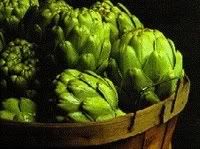
I know it's hard to believe, but before I moved over here to the UK I had never eaten an artichoke in my life, let alone cooked one. I don't think I'd ever even seen one, except in pictures. They always looked exotic and foreign and not at all like anything I'd want to cook, let alone eat. They looked vicious and cantankerous and hard to cope with.
I have discovered them though, since moving over here, and I quite like them, although I still hadn't cooked one until yesterday. Most of my artichoke experiences had been of the jarred and marinated or canned kind.
A native of the Mediterranean, the artichoke is a perennial in the thistle group of the sunflower (Compositae) family. In full growth, the plant spreads to cover an area about six feet in diameter and reaches a height of three to four feet. Its long, arching, deeply serrated leaves give the plant a fern-like appearance. The part we eat is actually the plant's flower bud. If allowed to flower, the blossoms measure up to seven inches in diameter and are a beautiful violet-blue color.
When faced with cooking one for the first time it's appearance can be somewhat daunting. It closely resembles something you might find in a desert somewhere and not anything you might want to eat, let alone prepare for cooking.
The artichoke makes no concessions to those who want a quick meal. They are not "quick" to fix, nor are they "fast" food. Why then do people eat them? Serious artichoke eaters will tell you that the reason for eating an artichoke is its unique, nutty flavor.
Some people cook the whole artichoke, and slip each leaf petal, one by one, through their teeth until they reach the delectable heart. Messy, fun to eat, with the tips of the lucious petals dipped in butter, they are delicious done and eaten this way.
I was in the grocery store the other day and they had a lovely pile of the dangerous looking beauties on special at two for £2 and so I decided to jump into the deep end with both feet and buy some and cook them. This artichoke virgin was ready and willing to give it all up once and for all!
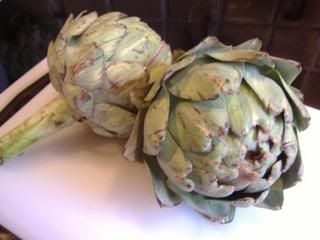
Looking at them sitting on my cutting board they looked somewhat scary and not a little daunting. I had a book that told me what to do with them so I decided there was no time like the present to get started and so I got out one of my sharpest knives and got stuck in.

First I cut off the stem near the base of the choke. Then I removed the tough outer darker green
leaves by bending them backwards until they snapped off near the bottom. There was ever so much that ended up in the refuse pile.

Using my small sharp paring knife I then cut off the dark green parts of the base and the leaf bottoms until the base was smooth and pale green. (I know, it seems like an awful waste doesn't it!)
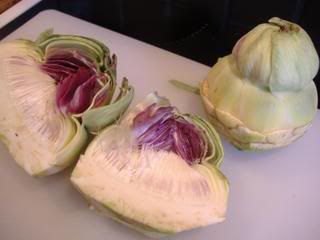
After that I cut the artichoke into quarters, and then cut out the choke with the same sharp paring knife. Apparently this is very nasty to eat and feels horrible in the mouth.
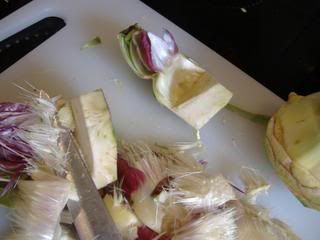
I trimmed the tougher leaf tops from each quarter so that all that remained was the choicest most tender part of the artichoke. As I cut them I dropped them into acidulated water because I had read that if you didn't they turned brown very quickly.
After having mastered or tried to master the art of the artichoke I have to say they are not as frightening as they once seemed, although to be perfectly honest, it did seem like an awful lot of faff and waste just to get what I ended up with after all that work!
What do do now . . . I know, how about a delicious potato and artichoke salad to go along with the chicken I am roasting . . .
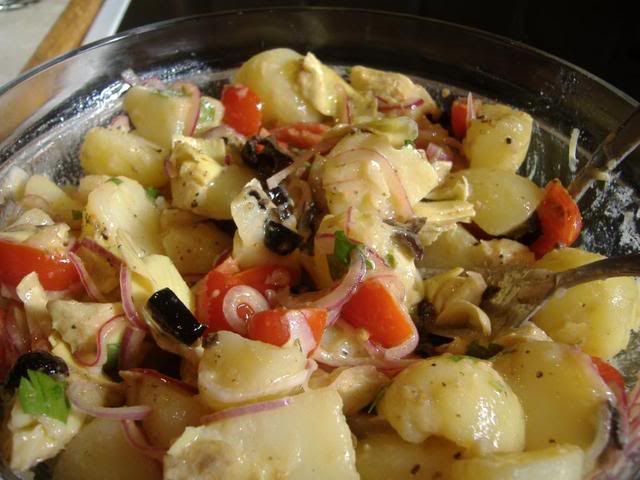
*Charlotte Potato and Artichoke Salad*
Serves 6 to 8
This is a delicious lemon and oil dressed potato salad with a bit of a mediterranean flavour to it. The perfect way to use the artichokes I had prepared.
2 3/4 pounds of charlotte potatoes
1 lemon halved
4 large artichokes
1 2/3 cup water
1/3 cup olive oil
1/3 cup dry white wine
6 whole peppercorns
6 coriander seeds
2 sprigs of fresh thyme
1/2 red onion, peeled and very thinly sliced
3 green spring onions, thinly sliced diagonally
2 handfuls of cherry plum tomatoes, halved
15 black brine cured black olives, such as kalamata or Nicois, pitted and chopped
6 fresh basil leaves, finely sliced into chiffonade
DRESSING:
1/4 cup fresh lemon juice
2 TBS Dijon mustard
3/4 cup olive oil
Sea salt and freshly ground black pepper to taste
Cook the potatoes in a large pot of boiling salted water until just tender, about 20 minutes or so. Drain well. Cool and then peel as soon as you can handle them. Cut into halves.
Halfway fill a large bowl with cold water. Squeeze in the juice from half of the lemon. Cut the second lemon half in half. Cut off the stem from 1 artichoke and rub the exposed area with the cut side of a lemon piece. Starting from the base of the artichoke, bend each leaf backward and snap off where the leaf breaks naturally. Continue to do this until the light green leaves are exposed. Using a small sharp knife, cut off all the dark green areas. This is the artichoke heart. Cut the heart into quarters. Rub all cut surfaces with the lemon. Cut out the choke and pink inner leaves from each section and discard. Place the artichoke heart sections in the water with the lemon juice. Cut off top two inches of artichoke. Repeat with the remaining artichokes.
Combine the 1 2/3 cup of the water, olive oil, wine, peppercorns, coriander and thyme in a heavy saucepan and bring to a boil. Drain the artichokes and add to the saucepan. Cook until tender, about 15 minutes. Drain well and cool. Cut into slices
Mix the potatoes, artichoke slices, red onion slices, spring onion, tomatoes, olives and basil in a large bowl, tossing gently to blend well.
Whisk together the lemon juice, Dijon mustard. Gradually whisk in the olive oil. Pour over the salad and mix gently together. Season to taste with sea salt and freshly ground black pepper.

I love artichokes, but I'm one of the dip and scrape the leaves people. Cleaning them like you did always seemed like to much work. Tossing them in the steamer and dipping the leaves in butter or mayo is just fun, easy and oh so good!
ReplyDeleteI laughed so loud at your title...too funny. But it is a wonderful post...now I know how to kill an artichoke whenever I see one. ;)
ReplyDeletehaha no more the artichoke virgin. We just stuff them whole and eat them leaf by leaf. It's fun and very tasty. A special dish at my house :)I'll have to post some soon.
ReplyDeleteThe next step on the road to artichoke addiction is to grow them - easy, they're like weeds, really - and then eat them very very young, so that you can eat the choke too. Then there's no real prep involved, and they are fabulous. You can't buy them that young, except perhaps occasionally in Italy. It's a real early-summer treat
ReplyDeleteJoanna
joannasfood.blogspot.com
Sounds really good and love Joanna's idea to grow them. I read one of her posts earlier in the Summer which made me want to grow them. The idea of not having to prep them that much is very appealing.
ReplyDeleteI love artichokes..Marc dislikes the fact that they are troublesome to eat so I don't prepare them. :/
ReplyDeleteartichokes are my VERY favorite! I just don't know how to eat them other than boiling them, ripping off the leaves and drowning them in butter. Your recipe looks wonderful, I am going to have to try it!
ReplyDeleteGorgeous recipe Marie! Bravo for braving the unknown!! I love them like this but I always feel guilty for "throwing away" the outer leaves! I'm with Katie that they make a perfect fat delivery system! ;)
ReplyDeleteBZ